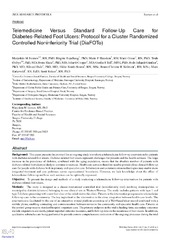Telemedicine Versus Standard Follow-Up Care for Diabetes-Related Foot Ulcers: Protocol for a Cluster Randomized Controlled Noninferiority Trial (DiaFOTo)
Iversen, Marjolein M.; Espehaug, Birgitte; Hausken, Marie Fjelde; Graue, Marit; Østbye, Truls; Skeie, Svein; Cooper, John G.; Tell, Grethe Seppola; Günther, Bodo Erhardt; Dale, Håvard; Smith-Strøm, Hilde; Kolltveit, Beate-christin Hope; Kirkevold, Marit; Rokne, Berit
Peer reviewed, Journal article
Published version

View/
Date
2016-07-18Metadata
Show full item recordCollections
Original version
https://doi.org/10.2196/resprot.5646Abstract
Background: This paper presents the protocol for an ongoing study to evaluate a telemedicine follow-up intervention for patients with diabetes-related foot ulcers. Diabetes-related foot ulcers represent challenges for patients and the health services. The large increase in the prevalence of diabetes, combined with the aging population, means that the absolute number of patients with diabetes-related foot ulcers is likely to continue to increase. Health care services therefore need to provide close clinical follow-up care for people with diabetes both in primary and specialist care. Information and communication technologies may enable more integrated treatment and care pathways across organizational boundaries. However, we lack knowledge about the effect of telemedicine follow-up and how such services can be optimally organized. Objective: To present the design and methods of a study evaluating a telemedicine follow-up intervention for patients with diabetes-related foot ulcers. Methods: The study is designed as a cluster randomized controlled trial (noninferiority trial) involving municipalities or municipality districts (clusters) belonging to one clinical site in Western Norway. The study includes patients with type 1 and type 2 diabetes presenting with a new foot ulcer at the initial visit to the clinic. Patients in the intervention group receive telemedicine follow-up care in the community. The key ingredient in the intervention is the close integration between health care levels. The intervention is facilitated by the use of an interactive wound platform consisting of a Web-based ulcer record combined with a mobile phone, enabling counseling and communication between nurses in the community and specialist health care. Patients in the control group receive standard hospital outpatient care. The primary endpoint in the trial is healing time; secondary outcomes include amputation and death, patient-reported outcome measures, and follow-up data on the recurrence of foot ulcers. In addition, qualitative substudies are being performed to provide a more comprehensive evaluation of the ongoing processes during the trial with the patients in the intervention and control groups and those health care professionals either working in primary care or in specialist care delivering the intervention. Results: The project has been funded. The inclusion of patients started in September 2012. Because recruitment goals were not met in the initial period, two more clinical sites have been included to meet sample size requirements. Patient recruitment will continue until June 2016. Data collection in the qualitative substudies has been completed. Conclusions: This telemedicine trial operates in a novel setting and targets patients with diabetes-related foot ulcers during a 12-month follow-up period. The trial addresses whether integrated care using telemedicine between primary and specialist health care can be an equivalent alternative to standard outpatient care.
